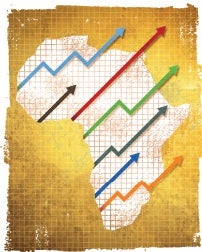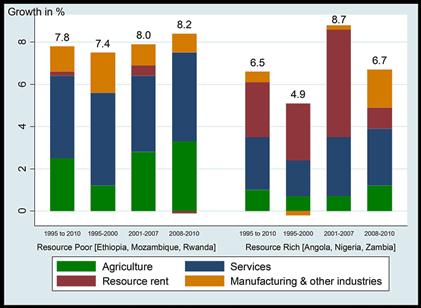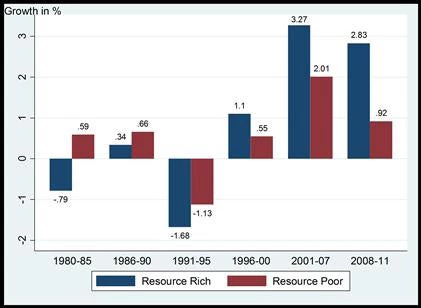 Co-authored with Luc Christiaensen and Aly Sanoh
Co-authored with Luc Christiaensen and Aly Sanoh
For a decade and a half now, Africa has been growing robustly, and the region’s economic prospects remain good. In per capita terms, GDP has expanded at 2.4 percent per year, good for an average increase in GDP per capita of 50 percent since 1996.
But the averages also hide a substantial degree of variation. For example, GDP per capita in resource-rich countries grew 2.2 times faster during 1996-2011 than in resource-poor countries (Figure 1). Though not the only factor explaining improved performance—fast growth has also been recorded in a number of resource-poor countries such as Rwanda, Ethiopia and Mozambique (before its resource discoveries)—buoyant commodity prices and the expansion of mineral resource exploitation have undoubtedly played an important role in spurring growth in several of Africa’s countries. Even more, with only an expected 4 or 5 countries on the African continent without mineral exploitation by 2020, they will continue to do so in the future. Yet, despite the better growth performance, poverty declined substantially less in resource-rich countries.
Figure 1: GDP per capita growth (SSA)
Using the available data, our estimates suggest that the $1.25 a day poverty headcount declined from about 65 percent during 1995-2000 to an estimated 49 percent during 2008-2011 in resource-poor countries. Contrast this with an estimated poverty decline of only 7 percentage points in the seven resource-rich countries covered in the data. Life expectancy, under-5 child mortality and access to sanitation also remained substantially below the levels attained in the resource-poor countries.
These results are consistent with the widely held beliefs that converting resource wealth into human welfare is particularly challenging. That said, not exploiting natural resource wealth is not an option either, as governments of resource-rich countries need mineral resources to finance their public investments and spending. Interesting clues on how to make growth more poverty reducing already emerge from the growth and poverty experience in Africa’s better performing resource-poor countries (such as Rwanda and Ethiopia – Figure 2), where agriculture also contributed substantially to growth, as in China in the past.
Figure 2: Decomposing growth (click on it to see it larger)
So, can Africa’s promising growth become more poverty reducing, especially in resource-rich countries? In technical terms, can Africa’s growth elasticity of poverty be increased? Several of Africa’s deeper running trends, including its mineral riches, elevated food prices, a demographic dividend and urbanization, hold such promise. But appropriate policies and institutions will be required to unleash this potential so as to benefit the poorer segments of the population. For example, in the area of mineral wealth, mechanisms by which African citizens, especially poor citizens, can get a direct share in their country’s wealth offer the possibility of increasing transparency and accountability of public spending, while simultaneously putting money in the hands of citizens themselves.
In agriculture, the rapid growth of domestic and regional markets following urbanization and expectations of high food prices, offer huge opportunities for Africa’s farmers. Policies that focus on increasing smallholder staple crop productivity prove especially poverty reducing, given the greater participation of the poor in staple crop production. The prospects are thus even brighter for several of Africa’s resource-rich countries, where the imports of staple grains have risen most, and where domestic staple crop production (such as rice) provides a viable and competitive alternative with substantial benefits for poverty reduction.
Finally, as Africa’s youth bulge is about to enter the labor force, the continent is poised to capture a demographic dividend: i.e. many more workers, fewer dependents and increased resources for public investment. However, this does not come automatically. Most importantly, the youth bulge will need to be absorbed in productive jobs. Labor productivity in the informal sector, where most of these youth will be employed, must be increased. In addition, for the poor to find their way to these informal jobs, careful attention must also be paid to the nature of the urbanization process. Indeed, evidence is emerging that migration out of agriculture into the rural nonfarm economy and secondary towns (as opposed to large cities) is more conducive to faster poverty reduction.
These and many more issues are discussed in greater depth in the latest issue of Africa’s Pulse (PDF 2.4MB). Read more and let us know your thoughts.



Join the Conversation